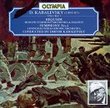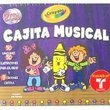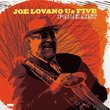| All Artists: Johann Sebastian Bach, Miklós Spányi Title: Bach: Sonatas for Viola da Gamba Members Wishing: 0 Total Copies: 0 Label: Bis Release Date: 3/1/2000 Album Type: Import Genre: Classical Styles: Chamber Music, Historical Periods, Baroque (c.1600-1750), Classical (c.1770-1830), Instruments, Reeds & Winds Number of Discs: 1 SwapaCD Credits: 1 UPCs: 675754141820, 7318590010617 |
Search - Johann Sebastian Bach, Miklós Spányi :: Bach: Sonatas for Viola da Gamba
 | Johann Sebastian Bach, Miklós Spányi Bach: Sonatas for Viola da Gamba Genre: Classical
Bach's sonatas for viola da gamba and keyboard aren't standard-issue solo works with accompaniment. They're actually rearrangements by the composer of earlier trio sonatas for two melody instruments plus continuo. So the k... more » |
CD Details
Synopsis
Amazon.com
Bach's sonatas for viola da gamba and keyboard aren't standard-issue solo works with accompaniment. They're actually rearrangements by the composer of earlier trio sonatas for two melody instruments plus continuo. So the keyboard part isn't just an accompaniment to fill in the harmony, it's an equal partner in melody with the gamba. This can be problematic for the harpsichord (the usual choice for these works), because the harpsichord can't sustain notes or vary dynamics the way bowed strings can. However, a number of keyboard instruments (including ancestors of the modern piano) were being developed in the mid-18th century, and Bach definitely knew about and experimented with some of them. The instrument Miklos Spányi uses here is the "tangent piano" or "cymbal"--sort of a hammered dulcimer with a keyboard. Its subtle variety of timbre and volume (well-deployed by Spányi) is fascinating--sometimes like a harpsichord, sometimes like a dulcimer, sometimes (especially in the slow movements, where the difference is most striking) like the fortepianos now being revived for Mozart and even Beethoven. Markku Luolajan-Mikkola (cofounder of Phantasm) doesn't quite make the viola da gamba sing the way Jordi Savall does (but then, who can?); he plays in a less cellolike, more understated style reminiscent of the instrument's heyday in 17th-century England--a style that works particularly well in the G-minor sonata. This release has more competition than you might expect--from cellists such as Casals, Ma, and Bylsma as well as the likes of Savall--yet Spányi's tangent piano in particular makes it well worth checking out. --Matthew Westphal
Similar CDs
| Crayola Cajita Musical Genres: Children's Music, Latin Music Label: Madacy | |
| Joe Lovano, Us Five Folk Art Genres: Jazz, Pop Label: Blue Note Records | |

 Track Listings (15) - Disc #1
Track Listings (15) - Disc #1


